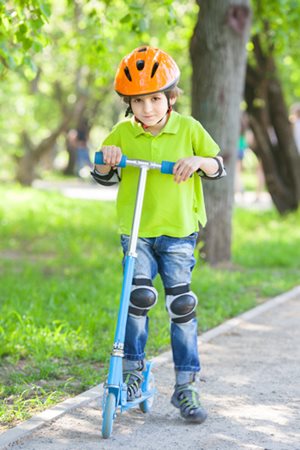Overview
There are electric scooters and manual scooters that you must push with your foot. They are a fun way for children to be active and get around. However, scooters are dangerous when used around cars and traffic. Injuries can also happen if the scooter is moving very fast and you fall off.
Common injuries
According to the Consumer Protection Safety Commission, 67,000 kids went to the emergency room because of scooter related accidents. Over 59,000 of these accidents occurred on manual scooters. Injuries are as small as minor cuts and bruises but can also be very serious, such as broken bones and head injuries.
Recommendations
- Children should not use a scooter if they do not have enough balance or coordination. A child under the age of 8 should never use a scooter.
- A parent should show the safety features of the scooter to a child before a child rides a scooter. This includes safety gear and brakes. The parents should then watch the child with the scooter in a safe, open area.
- Before riding – check that the steering column and handlebars are locked into place. Also check that all nuts and bolts are tight before using the scooter.
- Children should always wear protective gear when operating a scooter:
- helmet
- wrist guards
- knee and elbow pads
- Children should wear long pants and long sleeve shirt when operating a scooter.
- Children should wear proper shoe wear that won’t fall off and will protect the top and bottom of their feet. Sneakers are very protective. Flip-flops are not.
- Avoid dangerous ground or bad weather:
- No riding on steep hills
- No riding over obstacles
- No riding on slippery, sandy, or icy surfaces
- No riding on streets or any place where there are cars, buses, or trains.
- Do not use a scooter at dawn, dusk or at night.
- Do not do any stunts or jumps.
More Information
Resources
- Incidence and Description of Scooter-related Injuries among Children, Powell EC, Ambulatory Pediatrics, 2004 Nov-Dec; 4(6): 495-9
- Recreational Injuries in children: Incidence and Prevention, Purvis JM, JAAOS, Nov/Dec 2001, vol 9 no 6 365-374
Page QR Code:


 POSNA.org
POSNA.org

